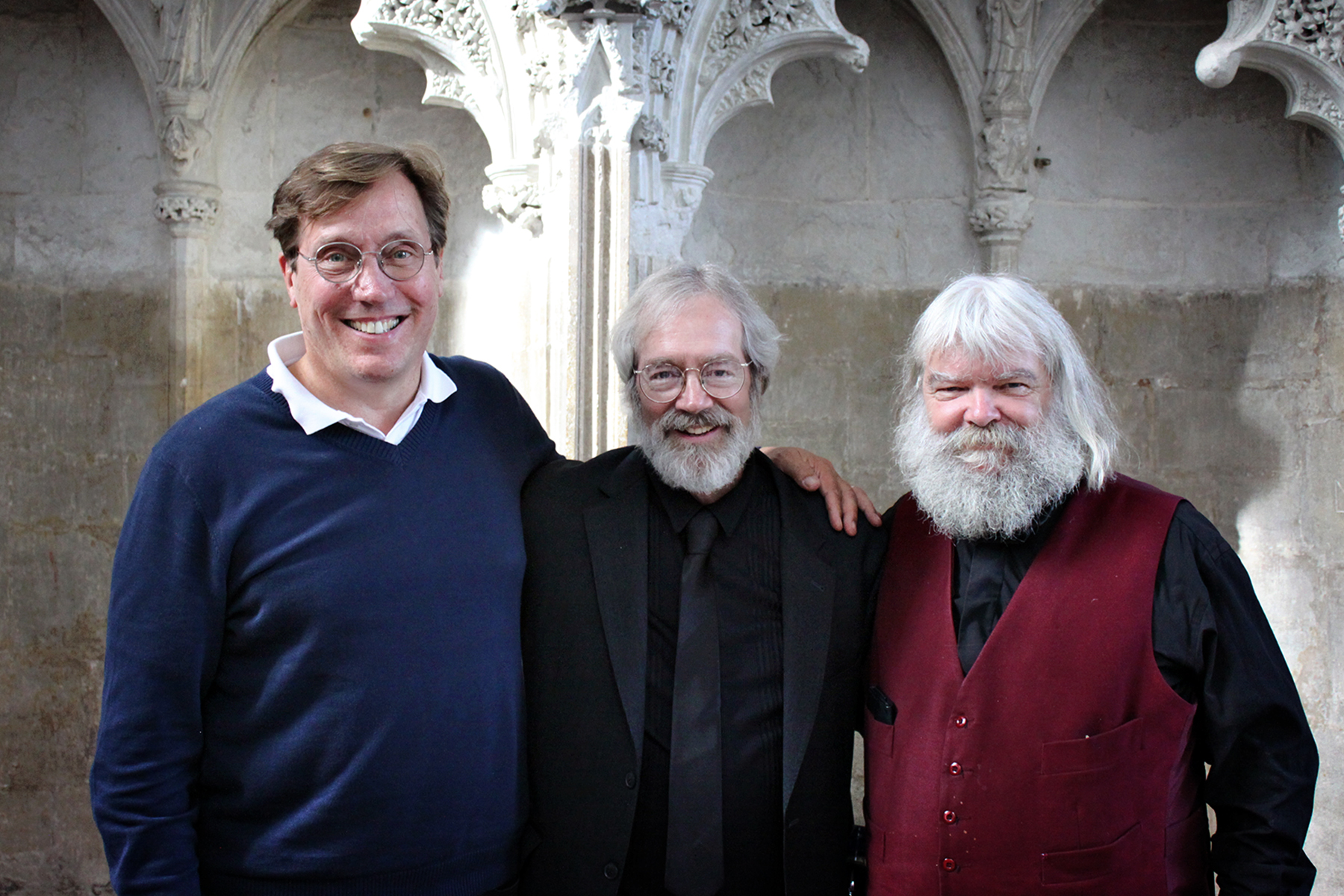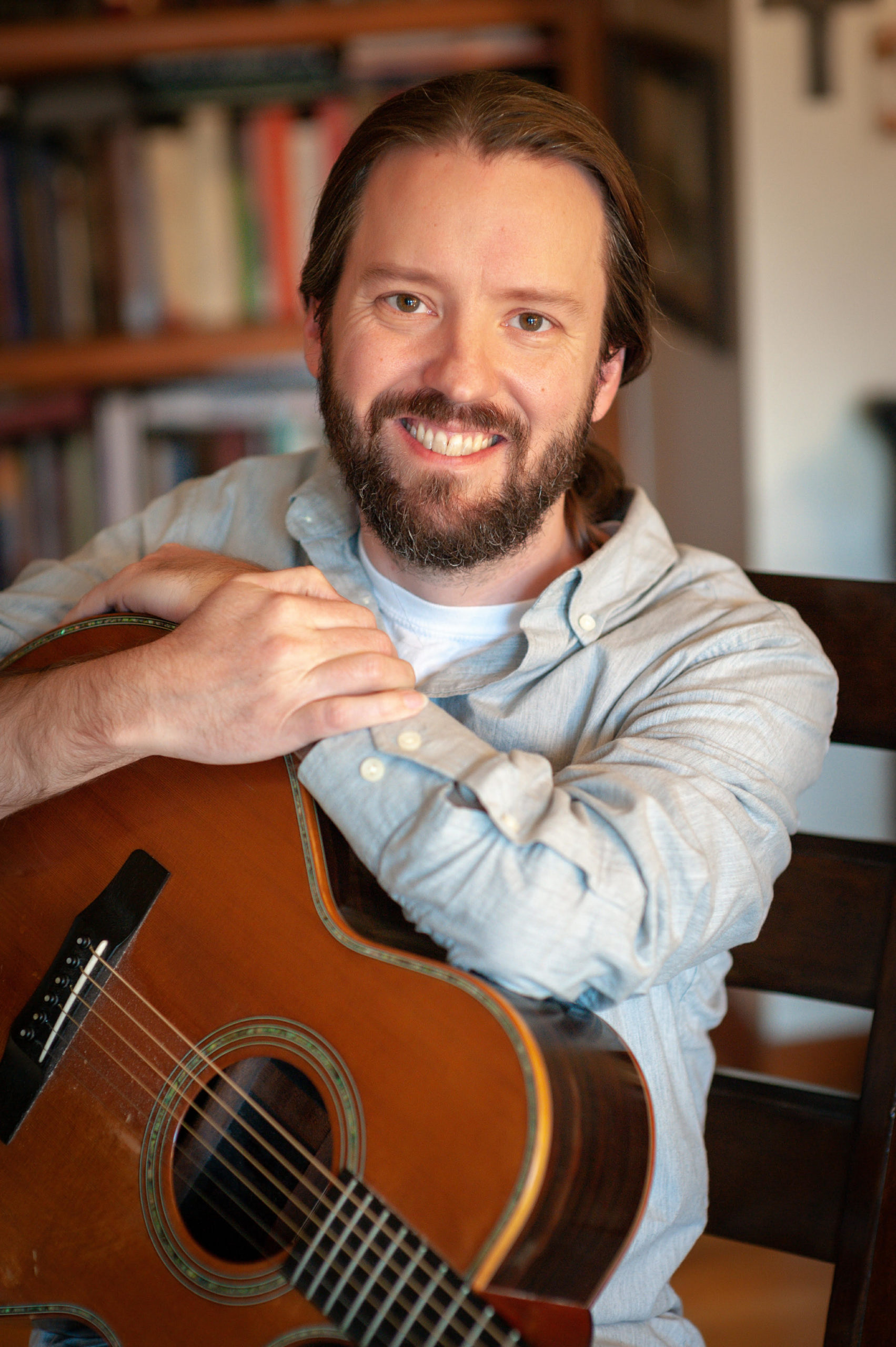In October 2018, I traveled to Laity Lodge outside of Kerrville, TX for the world premier of the Ordinary Saints project. Three artist friends: Bruce Herman, Malcolm Guite, and JAC Redford, collaborated to create this exhibit of painting, poetry, and music centered around the work of learning again to deeply see the people in their lives that have grown too familiar. “The ordinary saints, the ones we know, / Our too-familiar family and friends, / When shall we see them?” asks Guite in the project’s titular poem.
I flew from Atlanta to San Antonio and met up with my friends Diana Glyer and Lancia Smith. We drove far out into the Texas hill country until we turned off onto a little gravel road that wound down into a secret valley. When we reached the bottom, we drove our rental car into a shallow Frio river bed (after following signs assuring us that we were actually supposed to put the car in the river). The river became the road like some baptismal highway from which we emerged to climb back onto the shore leading to this little retreat center hidden like Rivendell in the dusty backcountry of the American West.
The three of us went because we love these particular three artists. We’ve each felt companioned by their work and friendship over the years. And we each felt that this project, being a collaboration, might have something special to say – a depth that could only be achieved by setting a profound mutual submission in love as the cornerstone of its creative process.
But let me take you back in time quickly to where I first heard of the Ordinary Saints project, and catch you up from there.
Back in the Summer of 2017, I travelled to England for the C.S. Lewis Foundation’s Oxbridge Conference. There, I first heard about Bruce Herman (painter), Malcolm Guite (poet), and JAC Redford’s (composer) planned collaborative project Ordinary Saints.
During a discussion panel at Oxbridge, Bruce Herman mentioned the book that had sent him off down the road toward the Ordinary Saints project: David Ford’s Self and Salvation: Being Transformed. In it, Ford says that,
“Christianity is characterised by the simplicity and complexity of facing: being faced by God, embodied in the face of Christ; turning to face Jesus Christ in faith; being members of a community of the face; seeing the face of God reflected in creation and especially in each human face, with all the faces in our heart related to the presence of the face of Christ; having an ethic of gentleness towards each face…”
Each of these three artists, through their respective mediums, would be responding to the faces of “too-familiar” loved ones, searching, as Guite puts it, to see, “the presence, glimpse the gold / That is and always was our common ground”. Painting, poetry, and song would face each other in an act of facing the gift of God’s image in the human faces around them.
It seemed that the Lord had been preparing my own heart to hear their conversation that July. I’ll mention just two examples among many.
The previous year, I’d been introduced to Josef Pieper’s little book Only the Lover Sings, as well as, Roger Scruton’s The Face of God. Both of these authors had captivated me by pointing to the face as the primary threshold over which the transcendent reality of personhood spills into the material world. Peiper had been urging me to “learn to see again” by cultivating deliberate attentiveness in a utilitarian world (what he terms leisure or contemplation). Scruton had outlined the dangers of ‘de-facing’ whereby we reduce persons into things and subjects into mere objects of exploitation. Both authors warned, like von Balthasar, that if we lose the ability to practice this kind of tender attentiveness toward the face we will forfeit any seeing into real Beauty; once we’ve done that violence to the gift of our humanity, we’ll no longer be able to “pray and soon will no longer be able to love.”
Needless to say, I kept my eye on the project as it progressed. I was so excited when I found out the completed Ordinary Saints project would be premiering at Laity Lodge last Fall with a full weekend retreat build around it, and that Bruce, Malcolm, and JAC would all be there. I scooped up a ticket as fast as I could.
October rolled around finally, and I made my way out to the West Texas hill country. I was praying this weekend would be a time set apart for seeing. My eyes, though they are inundated with images upon images, are most often overwhelmed by a dryness. Our screens offer endless wells to draw from, but seldom do any truly meet our thirsts. I was hoping this weekend at Laity would be different.
I was looking to look and hoping to be given eyes to see.
I appreciate these three artists titling their project Ordinary Saints, as it calls us to look closely in the places we may have overlooked, dismissing them as too ordinary. But G.M. Hopkins assures us that “Christ plays in ten thousand places / lovely in limbs, and lovely in eyes not his / to the Father through the features of men’s faces”. In a diving bird, a tolling bell, or a simple stone tumbling down a well “each mortal thing… deals out that being indoors each one dwells.” Everything ‘selves’, offering itself as it “acts in God’s eye what in God’s eye it is – Christ”, which is to say, it offers, too, a reminder of our true self in Christ.
The weekend at Laity was full – it was filled with spaces for lingering in front of faces, over words, within song. We gathered to pay the cost of attention, and be dipped in its currency of care, remembrance, and mingled light. Tolkien speaks of “man, sub-creator, the refracted light / through whom is splintered from a single White / to many hues, and endlessly combined / in living shapes that move from mind to mind.”
I allowed myself to commit to waiting before the faces Bruce had painted, the poetry borne from contemplating them by Malcolm, and the tuning presence of JAC’s music. They and their works are lights interlacing, faces facing and offering a view onto a Face. Their project has been for me an elixir to meet my thirst. Each like a clear glass that permits the eye to both pass through “and then the heavens espy” and to discover reflected there a better word about my own face.
Ordinary Saints created a holy space within which those of us gathered together might protect as well as practice both prayer and love. To dare to believe in beauty rather than reduce it in our despair to “a mere appearance in order the more easily to dispose of it”. Not to mention, Laity Lodge never fails to craft their retreats with such artful attention to hospitality, which, if rest and attentiveness to beauty in facing are to be possible at all, must be carefully cultivated and protected.
Having turned to face Herman, Guite, and Redford’s work of collaboration, I find myself wanting to do something more than look; I want to join in. Like the Life of the Trinity from which their collaboration emerges and with which it merges, the Ordinary Saints project is generative. Real loving collaboration – facing – always overflows into new life. This has been true for me. And I am grateful to these men for their courage to enter into the deep, loving work of seeing and making seen. The sum is greater than the parts, and they have made available something more than any one of them has made, because these three artists are themselves creating in participation with the Face of Christ, a Reality far greater and wonderfully beyond themselves.
Guite says, “All portraits carry something of the icon / Some inkling of the light behind the sill / Of all our seeming, of the unquenched beacon / Whose radiance we never see, yet feel / Just under everything.” In that way, their work, like Creation, is iconic. Iconic in the sense that it calls us to look at, then into, then through, then beyond and toward the God in whom all things have their being and from whom we are gifted with that “gold that is and always was our common ground”.
Here is an invitation to cease defacing, and linger ‘till we have faces’ given by looking.

That’s when the lover sings, Pieper says – when she sees herself being seen and finally sees herself as beloved in the light of God’s face.
The images in Matthew Clark’s Reflections on Ordinary Saints are (c) Lancia E. Smith. They are offered here with glad permission for Cultivating and The Cultivating Project. The featured image is titled “Laity Lodge Oak.”
Matthew Clark is a singer/songwriter and storyteller from Mississippi. He has recorded several full length albums, including a Bible walk-through called “Bright Came the Word from His Mouth” and “Beautiful Secret Life.” Matthew’s current project, “The Well Trilogy,” consists of 3 full-length album/book combos releasing over 3 years. Each installment is made up of 11 songs and a companion book of 13 essays written by a variety of contributors exploring themes around encountering Jesus, faith-keeping, and the return of Christ. Part One, “Only the Lover Sings” is available both as an album and as a companion book.
Matthew also hosts a weekly podcast, “One Thousand Words – Stories on the Way,” featuring essays reflecting on faith-keeping. A touring musician and speaker, Matthew travels sharing songs and stories in a van called Vandalf.
Leave a Reply
A Field Guide to Cultivating ~ Essentials to Cultivating a Whole Life, Rooted in Christ, and Flourishing in Fellowship
Enjoy our gift to you as our Welcome to Cultivating! Discover the purpose of The Cultivating Project, and how you might find a "What, you too?" experience here with this fellowship of makers!




Add a comment
0 Comments